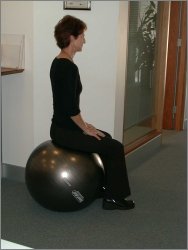How and Why You Need to Focus on Building Your Core …
and Good Posture Plus Six Top Core-Building Exercises
Your body has 29 core muscles, located mostly in your back, abdomen, and pelvis, that work to give you a stable center of gravity. Spanning from your pelvis to the base of your rib cage, your core muscles are what help you:

Exercise programs such as pilates and yoga are great for strengthening your core muscles. |
- Control movements
- Protect and support your back
- Gain greater balance and stability
Your core muscles are incredibly important because they provide the foundation for movement throughout your entire body. Strengthening your core muscles means that your spine will be supported and your body less prone to injury during sports activities and also during daily life.
Meanwhile, weak core muscles, according to the Mayo Clinic, can put you at risk of poor posture, lower back pain and muscle injuries.
Good Posture Is a Key to Good Health
“Sit up straight” and “Put your shoulders back” have been two of parents’ favorite mantras for eons. And, as you may suspect, this is one case where mother and father really do know best. Having good posture (which does indeed incorporate sitting up straight and putting your shoulders back) is very important for your health.

An upright posture conveys confidence and self-esteem. What does your posture say about you? |
Look 10 Pounds Lighter AND More Confident
Many posture enthusiasts claim that the correct posture can instantly make you look 10 pounds lighter. Meanwhile, sitting or standing upright is key to looking confident and displaying that confidence to others.
With the correct posture you can look taller, slimmer and at ease with who you are. Compare that to someone who is slumped over in their work chair, slouching while they walk or hunched up in general, and the difference is obvious, at least from the outside.
Good Posture Affects Your Health from the Inside, Too
Having correct posture does not just affect the way you look to others; good posture will pass along many health benefits to you. Primarily, these health benefits occur because when your posture is correct, your muscles, organs, joints and bones are all where they’re supposed to be. Stand or sit with improper posture, and unnecessary strain is inevitable.
“Strain issues, such as neck strain, low back pain or carpel tunnel syndrome are the most common effects of bad posture,” says Dr. Kristine Fortuna, assistant professor for the department of orthopedic surgery at Temple University in Philadelphia. “These come from overuse of the muscle.”
Of course, it is good to be able to handle overexertion problems at the onset. High quality supplements not-only addresses the pain of inflammation but also the underlying root causes that may exist at the muscles’ tissue. They may help maintain spinal stability and proper muscle tone even under stressful situations and also shorten recovery time after trauma from sports injuries or just the long-term stress and strain from bad postural habits. Ask at your next appointment for recommendations to see what might be beneficial for you.
|
How’s Your Sleeping Posture? Your posture while you sleep can make a difference in your sleep quality and your health. “Sometimes poor habits are the cause of a poor night’s sleep. Other times, it is because people sleep in a posture that puts a strain on their bodies,” says Michael Wiles, dean of the chiropractic program at Northwestern Health Sciences University in Bloomington, Minnesota. What’s the best sleeping posture? It’s “essentially the fetal position, on your side with your knees drawn up,” Wiles says. This position supports the natural curves of your spine. Sleeping on your stomach may be the worst sleep posture, as experts believe it can increase back pain by exerting pressure on joints in the back of the spine. |
Sometimes bad posture occurs from an inability to be able to simply relax. Perpetually tense muscles and shoulders put more strain on the body and make it more difficult to adopt posture. Some supplements containing calming herbs and minerals can support muscle relaxation.
From the moment you adopt good posture (see below for how), you will feel an improvement in the way you carry yourself. However, as you make good posture the norm for you, you will also:
- Minimize your risk of many neck and back problems.
- Ensure that your joints don’t wear abnormally, which can lead to arthritis.
- Be able to use your muscles more efficiently, because your bones and joints will be in the correct alignment. This will result in less fatigue, as your body will require less energy to move around.
- Prevent your spine from becoming fixed in an abnormal position. This can lead to constricted blood vessels and nerves, and problems with muscles, discs and joints, which can lead to headaches, fatigue and even problems with organs and breathing.
- Experience fewer strains and pains because you won’t be overusing certain muscles and joints, nor putting unnecessary pressure on bones, joints and organs.
- Put less stress on the ligaments holding the spine’s joints together.
What Does “Bad” Posture Look Like?
While most of us can point out someone else with bad posture, we may not realize it in ourselves. And, even if we do, we may not do anything about it.
“People are aware of easy wrist stretches they can do at the desk. But they don’t pay so much attention to their head’s jetting forward and their rounded shoulders,” said Doreen Frank, a physical therapist near Albany, New York. “I see lots of people with cervical thoracic strain and it’s very much related to sustained poor posture at the computer.”
Poor posture can come from many sources, including incorrect sitting and standing habits, obesity, pregnancy, an improperly arranged work environment, not enough flexibility and weak muscles. Poor posture habits include:
- Slouching and hunching your shoulders over
- Holding your head and neck forward and/or down
- Arching your lower back too much
- Commonly carrying a heavy purse or backpack on one side of your body
- Sitting on a wallet in your back pant’s pocket
- “Holding” a phone receiver between your neck and shoulder
- Slumping forward while seated
How to Get Good Posture Today

Increasing numbers of office workers are trading in office chairs for giant exercise balls in the name of better posture. |
While it will take time to adapt your body to naturally assume good posture (assuming you have strayed from it), you can use these tips to improve your posture today. With a little perseverance, your posture will be back on track (and, remember, modeling proper posture is essential to ensure that your kids have good posture, too!).
Good Posture Tips While Sitting
- Keep both feet flat on the floor (if your feet cannot reach the floor, adjust the chair or use a footrest)
- Align your back with the back of the chair
- Don’t slouch or lean forward
- Adjust the chair so your knees are even with your hips, or slightly higher, and your arms are at a 75-90 degree angle at the elbows
- Keep your shoulders straight
- Choose an ergonomic office chair with good back support
- Get up often and stretch
Good Posture Tips While Standing
- Keep your weight on the balls of your feet, not your heels
- Let your arms hang naturally by your side
- Keep feet about shoulder-width apart
- Don’t lock your knees
- Keep your head level and in line with your neck and spine, not pushed forward
- Keep your shoulders upright and stand up straight
Want to check your posture? Stand with your back to a wall. If your shoulders, bottom and back of head are all touching the wall, then your posture is correct. Do not be discouraged if your posture is not yet correct, work on it every day. Learn to relax if you are tense or under strain. Some rub on a topical magnesium gels can help relax tight shoulders or neck pain. Purposely set aside time to just relax into a good postural position and you may see your desired results sooner than you think.
If pain or discomfort persists please do not hesitate to make an appointment.
Now Let’s Strengthen Your Core Muscles with These Top Exercises
There are multiple ways to build your core strength, one of them being exercise programs such as pilates and yoga. Both of these methods work the muscles of the abdomen, lower back and buttocks to create flexibility and strength.
Another option is to focus on the individual exercises below, which will get your core muscles working together. The key to developing core strength, whether through pilates, yoga or individual exercises, is to make sure your core muscles are working together (rather than isolating each muscle group).
If you are new to strength training, you may want to seek the help of a personal trainer or fitness expert, who can show you how to properly position and align your body to get the maximum benefit.

The key to strengthening your core muscles is to perform exercises that get all the muscles working together (such as the ones below). Isolating the muscle groups will not have as beneficial of an effect. |
1. Bridge
Lie on your back with your knees bent (feet on the floor). Contract your abdominal muscles and raise your hips off the floor, holding the position for five to eight seconds. Slowly lower your hips to the floor, then repeat the move. For a more advanced bridge, try extending one knee, then the other, while in the bridge position.
2. Quadruped
Get on your hands and knees, keeping your hands below your shoulders and your head and neck aligned with your back. Contract your core muscles, then raise one arm off the floor and reach ahead. Return the arm to the floor, then repeat with the opposite arm and each leg. For a challenge, raise one arm and the opposite leg at the same time, then repeat with the other side.
3. Plank
Lie on your stomach, resting on your forearms with your palms facing down. Raise off the floor so you are resting on your elbows and toes. Keeping your back flat, contract your core muscles and hold for 10 seconds, then lower yourself to the floor and repeat. For a challenge, try stretching out one arm or leg at a time, or reaching out an arm and opposite leg at the same time.
4. Side Plank
Lie on your left side, then raise your body onto your left forearm, keeping your shoulders, hips and knees aligned. Rest your right arm on your side. Hold the position for 10 seconds, then repeat on the right side. For a more advanced side plank, raise onto your left hand with your hips coming off the floor and extend your right hand toward the ceiling.
5. Abdominal Press (the Push Away)
Lie on your back with your knees bent and your feet flat on the floor. Raise your knees off the floor, keeping them bent at a 90-degree angle. Rest a hand on each knee and push forward while using your core muscles to pull your knees toward your hands. Hold for six seconds, then return to the start position and repeat. For a variation, place your hands on the outside of your knees, and push your hands inward while your legs push out.
6. Segmental Rotation
Lie on your back with your knees bent and feet flat on the floor. Let your knees fall slowly to the left, keeping your shoulders flat on the floor. Slowly move your legs to the starting position and repeat on the right side.
Sources






